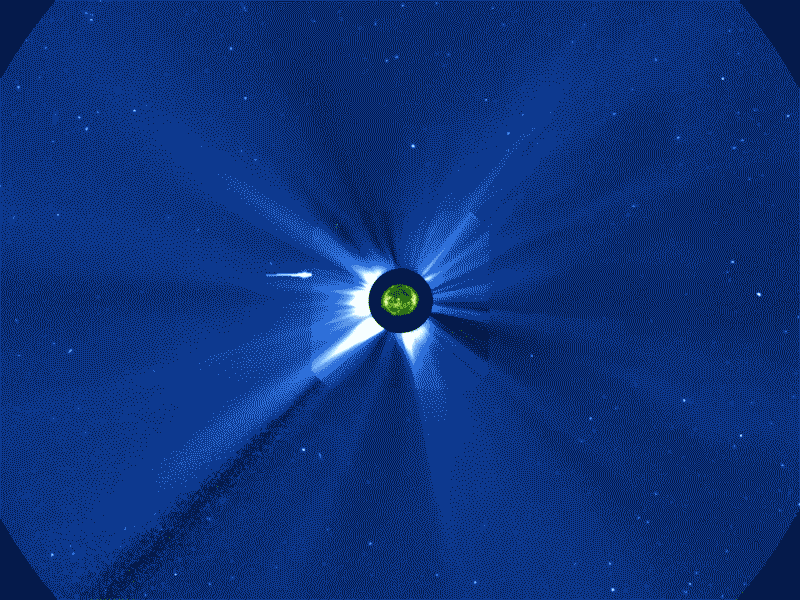Equipped with cutting-edge scientific instruments to measure the environment around the spacecraft, the Parker Solar Probe—designed, built, and managed for NASA by the Johns Hopkins Applied Physics Laboratory—has completed three of its 24 planned passes through never-before-explored parts of the sun’s atmosphere.
Four new papers in the journal Nature describe what scientists have learned from this groundbreaking study of our star—and what they look forward to learning next.
Launched in August 2018, the Parker Solar Probe is part of a mission to better understand the sun and its effects on space weather around our planet. Aboard the probe are instruments that will gather data and relay it back to teams at universities and laboratories across the U.S. Through careful engineering and a groundbreaking thermal protection system developed at Johns Hopkins, the probe is able to travel through the sun’s scorching hot atmosphere, called the corona, and provide up-close observations that will help scientists understand how to better protect astronauts and technology in space and will provide insights into the process by which stars are created and evolve.
VIDEO CREDIT: NASA GODDARD SPACE FLIGHT CENTER
“We’ve learned a great deal about our star in the past several decades, but we needed a mission like Parker Solar Probe to go into the sun’s atmosphere,” said Nour E. Raouafi, project scientist for Parker Solar Probe at APL. “It’s only there that we can really learn the details of these complex solar processes. And what we’ve learned in just these three solar orbits alone has changed a lot of what we know about the sun.”
The dynamic solar wind
Among the newly published findings from the mission are new understandings of how the sun’s constant outflow of material—called solar wind—behaves. Like the sun itself, the solar wind is made up of plasma, where negatively charged electrons have separated from positively charged ions, creating a sea of free-floating particles with individual electric charge. As solar wind approaches Earth, it appears to be a relatively uniform flow of plasma, but Parker Solar Probe’s observations reveal a complicated, active system closer to the sun that unleashes powerful bursts of light, deluges of particles moving near the speed of light, and billion-ton clouds of magnetized material.
Instruments aboard the Parker Solar Probe surveyed the state of the solar wind by measuring and carefully analyzing how the electric and magnetic fields around the spacecraft changed over time, along with measuring waves in the nearby plasma. These measurements showed quick reversals in the magnetic field and sudden, faster-moving jets of material—all characteristics that make the solar wind more turbulent. During these magnetic field reversals—dubbed “switchbacks”—the magnetic field of a particle whips back on itself until it is pointed almost directly back at the sun. They can last anywhere from a few seconds to several minutes.
The exact source of the switchbacks isn’t yet understood, but Parker Solar Probe’s measurements have allowed scientists to narrow down the possibilities. Among the particles that stream away from the sun are fast-moving electrons that move along the sun’s magnetic field lines and out into the solar system. These electrons were believed to always flow with the sun’s magnetic field lines, regardless of whether the north pole of the magnetic field in that particular region is pointing toward or away from the sun. But Parker Solar Probe measured this flow of electrons going in the opposite direction—flipping back toward the sun—showing that the magnetic field itself must be bending backwards. This suggests that the switchbacks are kinks in the magnetic field—localized disturbances traveling away from the sun.

Image caption:Parker Solar Probe has made new observations of energetic particles (pictured) that will help scientists better understand how these events are accelerated.
IMAGE CREDIT: ESA/NASA/SOHO
All of this solar wind activity affects our planet, interacting with Earth’s natural magnetic field, injecting damaging particles into the space where our satellites and astronauts fly, disrupting communications and navigation signals, and even triggering power outages. Parker Solar Probe’s observations of switchbacks suggest that these events will grow even more common as the spacecraft gets closer to the sun. The mission’s next solar encounter, scheduled for Jan. 29, 2020, will carry the spacecraft nearer to the sun than ever before and may shed new light on this process.
Powerful forces at work
In addition to understanding more about how the particles in solar wind behave, Parker Solar Probe’s measurements are bringing scientists closer to understanding how it flows out from the sun.

